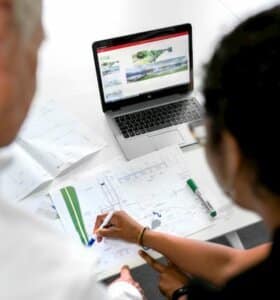
PROFESSIONAL PERSPECTIVE
There is a significant difference between an individual trained in the theories, principles, standards, and requirements of the career field and a true professional. Being a professional is more than holding a credential. A certificate or diploma is only an indication of knowledge in the area you have chosen to study. Many recently educated people search for a large salary, but they generally have only a moderate understanding of their career field and little or no training as a true professional.
The facts are simple. When employed, you typically sign an agreement indicating job requirements, work times, vacations, sick days, insurance provisions, and employer expectations.
Many employers have a dress code, a code of ethics, and other provisions you must follow. As an employee, you are an adult who is being paid to make things happen. You are a part of a working machine, but you are not the main wheel that makes it turn. Do your job, do it well, and keep the wheels turning, which is your primary function in an entry-level position.
In becoming a true professional, you need to keep in mind that with the availability of the Internet and other media, that your potential employer can check up on you and in many cases find out more than you want them to know. Facebook, MySpace, blogs, and other social networking areas on the Internet can be very damaging to your career if misused. As with your professional attitude, you need to keep some things private.
PROFESSIONAL NETWORK
You do need a professional network, and there are many of them such as LinkedIn or Plaxo that can help you network on a professional level. Now is the time to exhibit responsibilities to yourself and your employer.
In my current role, I am in constant contact with the leaders of the industry, representing some of the most prestigious manufacturing, engineering, architectural, and industrial firms in the world. When discussing the employment of future drafters and designers, I often request information on the reasons one individual is chosen over another when they are equally qualified. The answer is consistent; they employ those who reflect professionalism in all aspects of their individuality and areas of training.
PROFESSIONAL FACTS
The following are 15 facts that make you a professional:
- You must understand that your education begins after you have achieved your Your credentials only expose you to the knowledge and skills needed to perform the job. Real learning comes from day-to-day experience over many years.
- Consider the interview process, the interviewer, and the type of company when seeking to Investigate the company and determine what they do, their geographic area, and who owns the company. The company mission and employee expectations should match your goals and objectives.
- If you are seeking a career, do not take a job just to be Dissatisfaction may show in your work and performance, and it may result in you seeking new employment or being terminated. Employment changes can make it difficult to becoming reemployed. You should always keep a position for two or more years.
- Leave your attitude at You should show gratitude for your employment. Be proud that this company thinks you have the potential to be a part of its working family. Keep in mind that you are not the owner.
- Keep your opinion to yourself, focus on your job, and shape your This will bring you more attention and give you more excellent opportunities. Share improvement ideas with your supervisor. Ask if your work is acceptable and if there is anything that you can do better. Accept criticism with modesty.
- Many co-workers will do anything to advance, which is an unethical fact of survival in This activity can lead to discontent. Remember, you work for your supervisor, your job is to improve the product, produce a product, and increase company profits. Negative actions toward you by co-workers reflect their own inability to carry out their duties.
- Acting professional is a big part of your new You hold credentials, and with them comes a code of ethics that professionals follow. Here are some guidelines: (1) Be at your workstation, the computer turned on, chair adjusted, and ready to work a few minutes before work time. (2) Take your breaks at the designated. This is when you typically go to the restroom, get a coffee refill, or eat a snack. Work time is for production. (3) Your scheduled lunchtime includes You may find it more convenient to eat at work and have time to relax or do personal things. (4) Quitting time can be exciting, but do not stop early just to be out the door at 5 P.M. sharp. Complete a project and then deliver it to your supervisor if it takes a few minutes. You will have a head start on tomorrow and your career.
- Dress well for your interview and on the job, providing a professional Men should wear a shirt and tie, jacket, dress pants, and polished leather shoes with laces. Women should wear professional style clothing, fitting to the employment atmosphere. Women should avoid wearing dresses for the interview. Women should wear dress pants or a skirt, blouse, and matching jacket, or a pants suit, and avoid necklines more than four fingers below the high point of your sternum. Patent leather or athletic shoes should not be worn by either sex. Shoes should coordinate with your clothing and should be flats or low heels. Avoid noisy shoes. Wear professional colour such as navy, black, or grey. Do not wear a white, yellow, or chartreuse jacket. Your shirt or blouse should be white, light blue, or a pastel colour. Men should wear a tie that coordinates with the jacket and pants and wear a belt that matches shoe colour. In today’s liberal workforce, unisex clothing is readily available, and some of it looks sharp. However, in the interview process, make sure your clothing is cut to fit your body style. Accessories should be moderate, with no visible necklaces or dangling earrings. Cologne and perfume should be very subdued. For men and women, exposed body piercings in your nose, lips, and tongues and multiple sets of earrings should not be worn at the interview.
- Personal choices should be used on personal time or when found to be acceptable. Otherwise, you could jeopardize your employment opportunity. Keep in mind, you are applying for a job, and you do not know the preference of the company or the interviewer. The company makes the rules. Do not try to change policy if you want to keep your place. Observe the company dress code, so you know how to dress when you are employed.As a new hire, you should dress conservatively even if you see others are wearing jeans and polo shirts. If every- one wears shirts and ties, you do the same and make sure you have a jacket. Having a jacket or sport coat is good in case you need to attend a meeting. If the job requires you to go to manufacturing or to the field, you should have an appropriate change of clothes or cover-up. Finally, regardless of the dress code, keep a change of clothes in your car and be ready for an emergency dress up or dress down in a few minutes.
- Self-improvement is a good investment in the job. Research on work, processes, clients, and another project-related issue while on your own time. This can improve your production, broaden your mind, discover new project ideas, find software solutions and production methods, or network with other professionals.
- Most employment communication is proprietary and should not be discussed with anyone other than your supervisor or involved co-workers. Do not take information from work to home, unless approved by your supervisor.
- Write personal e-mails and make personal phone calls after work or on your personal cell phone outside the of- fice during break or at lunch. Using company equipment and company time is only for company business.
- After employment, you need to start preparing for you next move up the career ladder. Your employer may offer educational benefits. If you have access to the Internet at home, you can do webinars and take online training and technical training or expand your formal education. Your new knowledge, ability to speak on the technical subjects, and performance at work indicate your improvement without bragging. Provide information about your expanded learning during your annual reviews.
- Completion of your education is only one step in the overall progression of your career track. You should seek industry certification with a professional organization. Certification is based on industry standards and required knowledge at a specific level in the profession, and it is offered by industry organizations who are experts in the field. Certification competencies provide minimum performance and knowledge levels to your employer. Certifications can be related to software, codes, standards, technical writing, and other subjects. Additional training reinforces your abilities and your employability.
- Keep a work journal as an organizational tool and to improve your growth as a professional. Include specific assignment information, assignment performance, individuals involved, specific times and places related to the assignment, when you go to lunch, change projects, talk to a co-worker about a previous project, or attend a meeting about a new project. Entries made by time and date will stand firm in a challenge. The more you document, the better.
- While in school and after, you should be a member of any professional organization that relates to your profession. ADDA and Skills USA offer student memberships for the drafting profession. By being involved in professional associations, you will find a network of professionals who can assist you in every phase of your career path and offer opportunities, advice, and guidance you cannot receive anywhere else. As you leave your school and enter the workforce, you should retain your membership in the professional organization and become as active as possible.
Most organizations provide you with professionally rewarding volunteer opportunities on committees and groups to assist the profession. As you gain experience, you will see yourself working on projects with little assistance, moving up the corporate steps, being given more responsibility and increased compensation, and having opportunities you hoped for when you were first employed.
SUMMERY
The following summarizes our profession:
Drafting is the foundation and stepping-stone of any aspiring architect and engineer. It is a tedious profession, with days filled with non- stop drawing and making models of designs. It is through this process that one is able to learn to develop new skills and be introduced to styles that can be used as inspiration for personal design preferences in the future. Drafting molds the builders and designers of the future. Drafting is the profession of the hardworking and the persevering, the patient and the creative, the ambitious and the proud.
